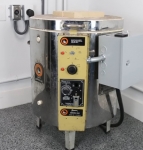I am in the process of building out a new workshop and I have always wanted to be able to fire ceramics and heat treat steel. I found an old Kiln on marketplace and bought it for $300. The downside to these old kilns is they basically have 3 settings. High, Medium and Low. Not a lot of adjustments there. Essentially this is just a really powerful oven, so I followed some simple wiring instructions to add a PID controller and a thermocouple. (my father in law owns a company where they make this kind of gear) So I was able to pick his brain a bit on this one. This was a fun project and has proven to be super useful and surprisingly accurate up to 2000 degrees Fahrenheit.
Hope you enjoy and learn something as I did.


 LinkBack URL
LinkBack URL About LinkBacks
About LinkBacks


 Reply With Quote
Reply With Quote


Bookmarks